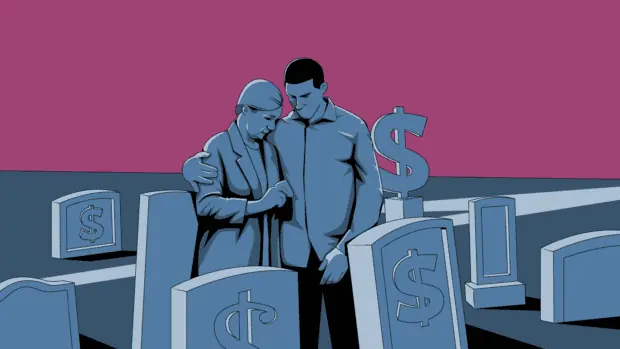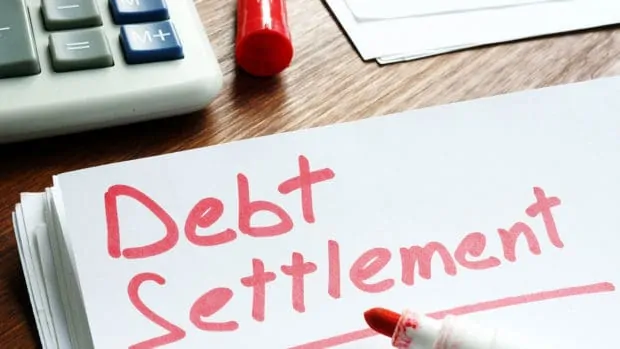Filing for bankruptcy is a big decision, but the process isn’t as opaque – or as frightening – as you may think.
Knowing what to expect when you file can help make the road ahead easier as you wait to get your debts legally eliminated without any tax penalty. With a solid understanding of what’s to come, you can prepare yourself and your finances as much as possible.
The steps of filing bankruptcy are different depending on which type you file, but this guide will give you a quick overview of both Chapter 7 and Chapter 13.
A snapshot of the filing process
It’s always recommended to get a bankruptcy attorney. The paperwork isn’t actually that hard to file, but the process itself can be tricky and you want to have a legal expert on your side to make sure everything is going smoothly.
Once your case is filed, a trustee will be assigned to administratively review the paperwork and your debts in a means test to make sure you’re not committing fraud.
That may sound a little scary, but really, as long as you’re not gaming the system – like running up a bunch of debt on new credit cards right before you file – you should be fine. Your bankruptcy attorney is there to guide you on avoiding any filing issues. It’s one of the big benefits of hiring a licensed attorney that specializes in bankruptcy to be your legal advocate. The means test will just confirm if you’re eligible for bankruptcy and which type you should file.
Things to know as you file bankruptcy
Think bankruptcy is a free ticket to a fresh start when you’ve messed up? Not really. You need to know…
- Not all debts may be wiped out through bankruptcy. Things like court-ordered child support and alimony can’t be discharged. Tax debt and federal student loans are only dischargeable in certain circumstances. But IRS debt older than three years can be eliminated in bankruptcy. Private student loans are being eliminated in bankruptcy more often these days.
- You must list all of your debts in your filing. In some cases, people try to keep one or two debts out with the intent that once the bankruptcy is final, they can at least pay that debt back. If you have reasons you want to pay a particular debt, your attorney can enter a reaffirmation agreement on your behalf. Ultimately it will be up to the creditor to keep the account open, so talk to your creditor first and make sure you discuss it with them before assuming they will let you keep the account.
- You can be held responsible for recently incurred debts. Most of the BAPCPA guidelines focus on preventing people from racking up debt just prior to filing. If you go out on one last shopping spree on your credit cards before you file, your creditor can move that these are fraudulent charges. In that case, the debts would not be discharged. Even worse, your entire bankruptcy case could get thrown out. Typically, these are debts originated in the 90 days before filing.
- You won’t lose the shirt off your back. While bankruptcy law varies from state to state, every state has exemptions in what can and can’t be taken. Clothes and household goods are almost always protected. Your car and even a home (up to a certain value) may also be protected. Qualified retirement plans (IRA/401(k)) are typically safe, too. Nobody wants your old stuff. Some people have wrongly assumed creditors will come and clean you out. That is just not true.
What bankruptcy can do to help you
Bankruptcy isn’t a free ride, but it’s also not the end of your financial world. In truth, if you file correctly, it can help you hold on to some of your most valuable assets and get a fresh financial start at the same time. Your credit may even recover faster than if you had continued to struggle at paying off your debt yourself.
Filing bankruptcy also prevents creditors and collectors from contacting you or taking any additional action once they know you have filed for bankruptcy. It stops everything quickly.
You just need to be smart about it, file when it’s time to put a period on things and hire a good attorney.
Assets that a timely bankruptcy filing can help protect:
- Your IRA and 401(k) are both typically protected in bankruptcy.
- Any 529 college savings plan is usually protected.
- In some cases, you can even save your home from foreclosure in a bankruptcy decree, depending on where you live.
- The same is true for your car loan.
- Bankruptcy stops wage garnishment.
- It eliminates judgments against you.
- In most cases, it can also stop a pending lawsuit on your debt.
How to file for bankruptcy
1. Analyze your debt.
Your analysis should only focus on one question, “Are my debts creating a financial hardship that prevents me from paying off my debt, building an emergency fund, or saving for retirement?” If the answer is yes, bankruptcy might be the right move.
You can call a credit counselor for free to explore your options. They can tell you about other debt relief methods, such as debt management programs, debt settlement, consolidation loans, balance transfers, and more.
2. Take a pre-bankruptcy course
Everyone who files bankruptcy must take a pre-bankruptcy course to meet an administrative requirement. Generally, the course is not a big deal and just needs to be completed.
The course itself takes about two hours to complete. You can do it online or over the phone through an agency approved by the Department of Justice.
Fees for this course are usually around $20 to $40, but you can apply to have this fee waived. Your income must be below 150% of the poverty line to drop the fee.
Keep the certificate you receive at the end of the course. The court will require proof you completed it. The course must be completed within 180 days prior to the date you file.
3. Choose which type of bankruptcy is best for you.
There are two main types of personal bankruptcy: Chapter 7 and Chapter 13. Your income, amount of debt, and future goals all affect which one is best for you. With a Chapter 7 bankruptcy, your debts are eliminated in about 90 days.
Types of Personal Bankruptcy.
No one wants to wind up in bankruptcy, but in some cases, it is the only option to get a fresh start – here are the basics.
First, there are two types of personal bankruptcy. Chapter 7 bankruptcy is where your non-exempt assets are liquidated to pay off as much debt as possible and then the remaining balances are written off. Most often, your home, vehicles, and retirement accounts are exempt.
With a Chapter 13 bankruptcy, a judge will assess your situation and designate a trustee to establish a payment schedule to pay off your debts. This chapter is normally used for people who are behind on their mortgage payments, back taxes or who have child support issues.
You will make payments every month until the debts are satisfied according to the court-approved repayment plan.
Once the payments are complete, any remaining balances are written off. Every filing requires a means test.
A means test is where your income level is compared to the median income in your state. This determines if you qualify to file and what type of bankruptcy you can elect. You’ll be required to go through financial counseling to receive a certificate before you file.
Chapter 13 bankruptcy can be a better option than Chapter 7 bankruptcy if you have assets that you want to protect. Filing for bankruptcy can stop the foreclosure process if the bank is trying to take your home.
A chapter 13 bankruptcy will stay on your credit report for 7 years. And a chapter 7 bankruptcy will stay on your report up to 10 years.
Having these negative marks on your credit report may make it difficult to qualify for loans and new lines of credit for a period of time, but it’s not impossible and you can take steps to rebuild your credit again.
To get started, simply fill out our form or better yet, call us now, and we’ll match you with the best solution for your situation. We are A- plus rated by the better business bureau and have helped thousands of people become financially stable.
So, don’t struggle any longer, give us a call. When life happens, we’re here for you.
Chapter 7 bankruptcy
This type of bankruptcy is also known as “liquidation bankruptcy” or “straight bankruptcy,” It is the fastest and least expensive way to get protection from your creditors and a quick fresh financial start.
It turns out only 4% of Chapter 7 filers have to get rid of any of their assets at all[1]. This is one of the fastest ways to get out of debt, and since your credit has probably already taken a big hit from being overextended and late on some bills, the additional impact will be not a showstopper. People that file for Chapter 7 bankruptcy will start to recover faster than those who opt to repay debts over time or with Chapter 13.
Chapter 7 takes 90 days to complete. It will stay on your credit report for ten years after discharge. Fortunately, its effect on your credit lessens with each year that passes. You can also start taking steps to increase your credit score immediately after discharge.
But if you aren’t selling off everything you own, then what are you doing in Chapter 7 bankruptcy? Basically, you’re telling the court that you can’t afford to repay your debts at all. You get to make a quick exit and get a fresh start – and start repairing your credit right away.
Chapter 13 bankruptcy
Unlike Chapter 7, Chapter 13 involves a three- to five-year payment plan. You repay some of what you owe to your creditors and keep your assets.
There will be a meeting scheduled that your creditors may attend, although few do. The bankruptcy trustee will approve the repayment plan. Then, you make all payments through the trustee.
If you make a steady income and you’re worried about your assets – or if you need to stop a foreclosure or repossession – Chapter 13 may be a good choice. It also only stays on your credit report for seven years compared to Chapter 7’s ten years. However, keep in mind that many Chapter 13 filers end up switching to Chapter 7 because of difficulties in making the monthly payments. The majority of people never complete the full Chapter 13 repayment plan.
4. Determine your property exemptions
Depending on its value, much of your property may be exempt from bankruptcy liquidation if you file Chapter 7. State and federal laws determine exemptions. You’ll claim your bankruptcy exemptions in the Schedule C form.
In Chapter 13 bankruptcy, nonexempt assets aren’t sold, but you must pay for them over time through your repayment plan.
Exemptions can require the expertise of a bankruptcy attorney since they are not always straightforward. Sometimes you can use federal exemptions or state exemptions. It can get confusing.
5. Redeem or reaffirm secured debts
Secured debts are tied to money or a piece of property, such as a car loan or a mortgage. Redeeming the debt means filing a motion with the court and paying the lender the value of the property in a lump sum.
Reaffirming a debt means signing reaffirmation agreements from the court. Unlike redeeming, reaffirming a debt means you get to keep the property while you continue making the same monthly payments. You must fill out reaffirmation agreements within 45 days after meeting with your creditors.
6. Fill out and file the forms
This part is tedious and leads to the majority of bankruptcy filing mistakes. While you can fill out the forms yourself, the answers you give can have an impact on other parts of the form and wrong answers can eliminate legal protections. All the forms are online and all you need do is print them out, fill out the required information, and mail them to the court. Find your local court by searching the U.S. Federal Court Finder. But the best advice is to never complete the bankruptcy process yourself. Hire a bankruptcy attorney that is a legal expert in what the rules are, how to best complete the forms, understands the local procedures and process, and is your legal representative.
Once you file, you are granted an automatic stay from further legal action and collection efforts. This means that once you have informed your creditors and collectors, they can no longer call you about the accounts included in your bankruptcy filing. It also stops all collection suits and foreclosures.
7. Pay the filing fee or request a fee waiver
The filing fee for Chapter 7 is $338. You can apply to have the fee waived using this form.
If you’re not eligible to have the fees waived, you can request to pay in smaller, more manageable installments.
The filing fee for Chapter 13 is $313. Consumers can’t usually get this fee waived or pay it in installments. If you file Chapter 13, get ready to pay this in a lump sum.
8. Make sure you are eligible
For both Chapter 7 and Chapter 13 bankruptcy, you must file a means test that determines your eligibility. The means tests ask you to report your monthly expenses and your monthly debt payments as well as any lawsuits against you. Again, this is why it is smart to hire an attorney to represent you. There are often factors that qualify people for a Chapter 7 bankruptcy when they are above the income requirement. Your attorney knows the technical details of how to properly calculate and complete the means test.
The court will use the means test documents to judge your ability to pay your current debts. If they decide you have the means to pay, you won’t be able to continue. If you do meet the criteria, you can continue with the bankruptcy process.
9. Get assigned a bankruptcy trustee
When the court accepts your bankruptcy filing, you’ll be assigned a trustee. The trustee does not represent you and will not be your guide through bankruptcy. Your bankruptcy attorney is the only person that has a legal obligation to represent you and your interests. The trustee will administratively review all your documents and, if you’re filing Chapter 13, you will make all your payments through the trustee.
10. Meet with creditors and attend a confirmation hearing
Chapter 13 bankruptcy requires there to be a meeting at which few if any creditors attend. Then you must attend a confirmation hearing. Creditors can object to parts of your repayment plan and changes can be made before the plan is officially confirmed.
11. Complete a debtor education course
Before you make your final monthly payment for your Chapter 13 bankruptcy repayment plan, you must complete a post-bankruptcy education course. You will learn about personal finance management and get a completion certificate to file with the court. Again, it is just something you have to complete.
You also have to complete a debtor education course for Chapter 7 before you can receive your final discharge.
12. Get your discharge
In Chapter 7, you’ll get your discharge within 90-120 days. In Chapter 13, this will take three to five years because that’s how long it usually takes to complete the payment plan.
13. Repair and rebuild credit
You don’t have to wait until bankruptcy is off your credit report to start rebuilding your credit. Start by monitoring your credit so you know where you stand.
Then, look into the many ways you can repair your credit after bankruptcy and get the credit you want for a brighter financial future.
Filing again
Few people ever file for bankruptcy a second time. There are restrictions on how many times you can file bankruptcy in a certain amount of time.
You must wait eight years before filing for Chapter 7 bankruptcy a second time. If you filed Chapter 7 first and want to file Chapter 13 this time, you only have to wait four years. If you filed for Chapter 13 first, you must wait 6 years to file for Chapter 7. You may be able to file sooner if you paid back all or at least 70 percent of your unsecured debt.
Hopefully, the pre-bankruptcy counseling and debtor education courses helped and now you are on solid financial footing. If you’re still struggling with debt, you can call one of our experts for free to learn about possible debt relief solutions.
<a name=”footnote”></a>






